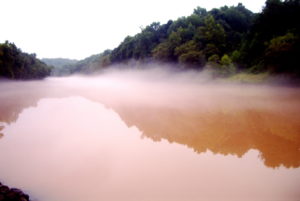Each morning we wake to find ourselves on a river upon which we have never been, we proceed in uncharted waters, and we do not know where we are headed. As Wisdom students we’ve learned that it is not so much about needing to know where we are going but rather knowing where to see from and how to find our way in unknown waters. At this time, we are in the midst of the ongoing mental health epidemic in the aftermath of the Covid-19 pandemic, economic fragility, climate crisis, our kin caught up in the horrors of war, and continuing to face the deep rooted political polarization, racism and social injustice in the soils of the earth in the land called the United States. As we all continue to learn how to truly address the deeper levels of these systemic realities in our predominant mental structure of consciousness individually and collectively, we can be re-grounding ourselves in Seeing with the Eye of the Heart, and returning to The Tools of Wisdom which support this aim.
Cynthia reminds us that our world is part of a vast inter-realmic, ever-changing, unfurling, dynamic “dance of becoming.” And no matter what external circumstances are taking place we can begin to pay attention to the more subtle ways these realms want to be in relationship with us and that the divine may want to manifest through us. She says:
There is always a kind of cosmic ‘downloading’ going on, as the divine qualities seek new streambeds to flow through, the imaginal realm presses against our physical one in an alchemy of transformation, aching, it seems, to come into finitude. And from our end, we live in the cosmos not as exiles yearning for the absolute but as alchemists and artists teasing the shape of the divine emerging out of the eternal and into the now. (p. 82)
Our common shared post right now is to become “alchemists and artists” able to perceive the “divine archetype” aching to come into form. Our portal into the “dance of becoming” is through “the power of creative perception” more closely understood as “a creative midwifery that has to do with intuiting the new patterns as they arise in the imaginal and helping birth them into form” (p. 83). In order to do this we must learn to see with the eye of the heart.
This is something that Cynthia has taught in some form or another in every book of hers and in every Wisdom School I have participated in. As her students, we’ve been training for times like we are in now. And yet it seems there is a quickening, an urgency to develop our capacity to see from the heart even more aptly. Humanity is on another precipice and in desperate need of midwives who can help birth something new into form. It is not inevitable that we will make the passage through this eye of the needle, but it will be less likely if we do not take up our role in the dance.
Cynthia says, “spiritually understood, the heart is an organ of astonishing perceptivity and versatility that when fully awakened and tuned allows us to play our part in the dynamism of creation.” This chapter brings us back to the familiar but never overstated truth that the heart is not the seat of our “personal emotional life.” An imperative distinction in a time when individual emotions run high and our global nervous system is activated. She returns to Kabir Helminski’s description of heart capacities as “psychic and extra sensory awareness; intuition; wisdom; a sense of unity; aesthetic, qualitative, and creative faculties; and image-forming and symbolic capacities. . . with an intuitive ability to pick up the signals from the imaginal realm” (p.85). Are we not being asked to cultivate these capacities even more fervently? With a precision and unshakable steadiness like never before?
Cynthia is clear: only as our heart comes into resonance with, and our entire being surrenders to, the qualities of divine intelligence, beginning with “love, mercy, and compassion,” can heart-knowing take place. “Creative perception is ultimately, then, an act of love” (p. 86). It is our imperative task to learn to see and know in these ways in order that we might live out our path of conscious love.
I spent several summers in my later teens as a white water raft guide. The river was itself in a perpetual state of change and although we could learn a stretch of the river with the rapids to be taken head on, the holes to be avoided, and the eddies to be found, we had to learn how to read water. I wouldn’t have recognized it at the time but this reading required presence in all three centers (intellectual, feeling, movement) in order to see what route was needed each time. If not present enough to see and respond to the deeper patterns of the water in each moment, each pass down the river, carnage would be the consequence.
In the Wisdom tradition, the passions and “fantasies of our own mind” are what cloud the heart, distorting our ability to see and respond in the now. Cynthia shows us that we must purify the heart and this “begins with getting beyond ‘the fantasies of our own mind’—which for better or worse means bridling the imagination” (p.88). What can be observed in our current circumstances is an unbridled collective imagination. She tells us the undisciplined imagination is the only prerequisite for the devil “whatever one may take this to be, whether an external or internal contrary force” to enter. We don’t want fear, anger, or any other egregore (group thought-form) of the uninhibited imagination, to become the devil of our time. We need those who can see these collective mirages for what they are and contain the imagination “between the twin banks of attention (teaching it to stay put at a single point) and surrender (letting go of all phenomena as they occur)” (p. 90).
In this chapter, Cynthia brings us to the practice of lectio divina, or sacred reading as a way of gaining agency with the imagination. Through the ongoing engagement of this practice, “knowledge begins to deepen into understanding, and understanding into visionary seeing” (p. 92). And she tells us this “deepening understanding unfolds in four stages.” The first stage, the literal, “is all about facts and linear causality.” In the second stage, called Christological, one learns “how to see analogically, in terms of meaningful coincidences, symbols, and resonance.” The third, is called the “tropological “which means having to do with growth” and one “allows the images to form their own patterns and cross-weavings.” (p. 94). The fourth and final is called the “unitive” and “at this level of understanding, we become not only sensitive interpreters of the patterns but actual co-creators” (p. 95). The seeing becomes simultaneously an engendering.
Can we wean ourselves from the “junk food” of passions and fantasies, and develop the eye of the heart that can read the text of our current circumstances, the river where the inter-realmic waters of the finite and the infinite meet? Can we surrender to the river in such utter vacuity that we become the river and as part of its coherence, fashion its course just as dance partners shape the pattern on the floor that is danced?
Cynthia teaches that once the eye of the heart is open, the artistry of conscience can begin. This conscience, she says:
…is the heart’s own ability to see the divine hologram in any situation no matter how obscured, and to move spontaneously and without regard for its personal well-being in alignment with that divine wholeness. When conscience awakens in a person, it brings not only the obligation but also a mysterious ability to be present in exactly the right way. (p. 98)
It can begin to guide us down the river of the now as it discerns and moves as the coherence. We must tune our heart with collected haste. As Bill R. has said, “we no longer have the luxury of being Wisdom students;” we must take our place and become “Wisdom.” Cynthia reminds us that we have support from the Conscious Circle of Humanity “to help negotiate a sharp bend in the highway of cultural history” (p 96). Are we not on a sharp bend in the highway, the river?
If we are going to read the water of this particular bend in the river, we are going to need to lean into the practices that tune our heart to perceive, but we cannot stop there. The Wisdom path is about perceiving and then moving into voice and action in the actual conditions of our lives, in the very particular moment of cultural history we are in. Right now there is wise action to be taken in this dense realm as we continue to navigate the challenges on our collective plate.
There is wise action to be taken as we continue to re-enter the world from our cells and houses amidst a virus that is still in our midst without trying to return to a capitalistic consumeristic ‘normal.’ But this work here, now, has to be approached from a qualitatively different mind, a mind that is deeply embedded in the actual heart, with its steady beat and heft and quality of aliveness rooted in the physical body on this plane and anchored in the imaginal realm. The Wisdom way only takes shape in the body and the transformation required must happen in the body, in our individual and collective cells. Our ancestors, the conscious circle of humanity, are here to support and guide us. Together we co-create a new intelligence and shape a new current.
Heather Ruce contributes to the Wisdom community in many ways, she is on the Wisdom Waypoints Board, works as a TA for the CAC’s Introductory Wisdom School 14 week courses; offers Wisdom practice circles, lectio divina groups, ongoing Collective Pause Meditation & Practice; and currently holds the post for our ongoing the Friday morning Wisdom Meditation. Heather has contributed to several posts on Wisdom Waypoints. You may find links to those posts, her website and read more about Heather here on Wisdom Waypoints.








Thank you for your thoughtful words. What book are you quoting from?
Hi Barbara, the book is “Wisdom Way of Knowing” by Cynthia Bourgeault